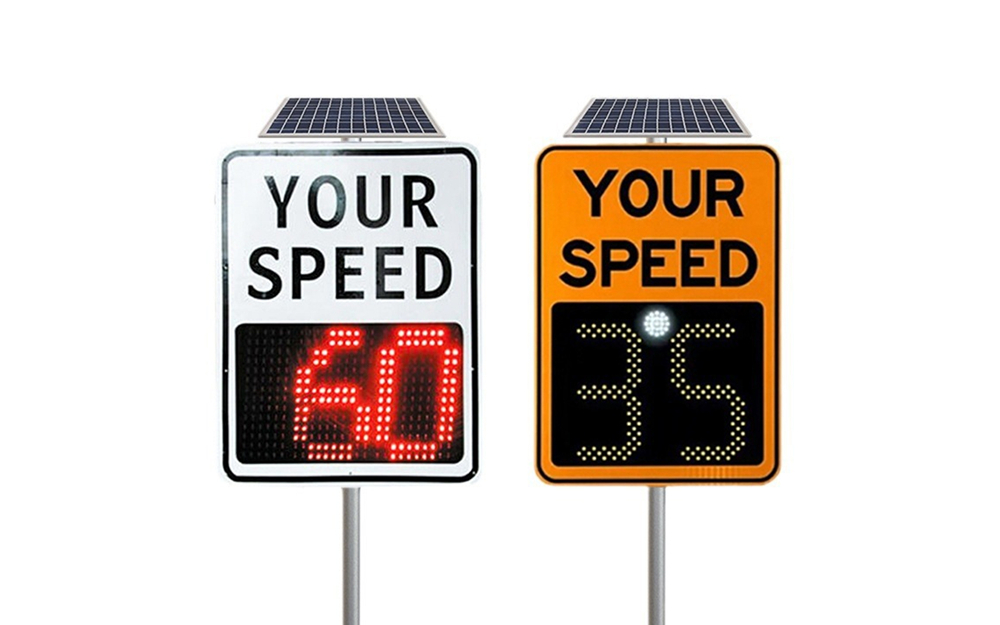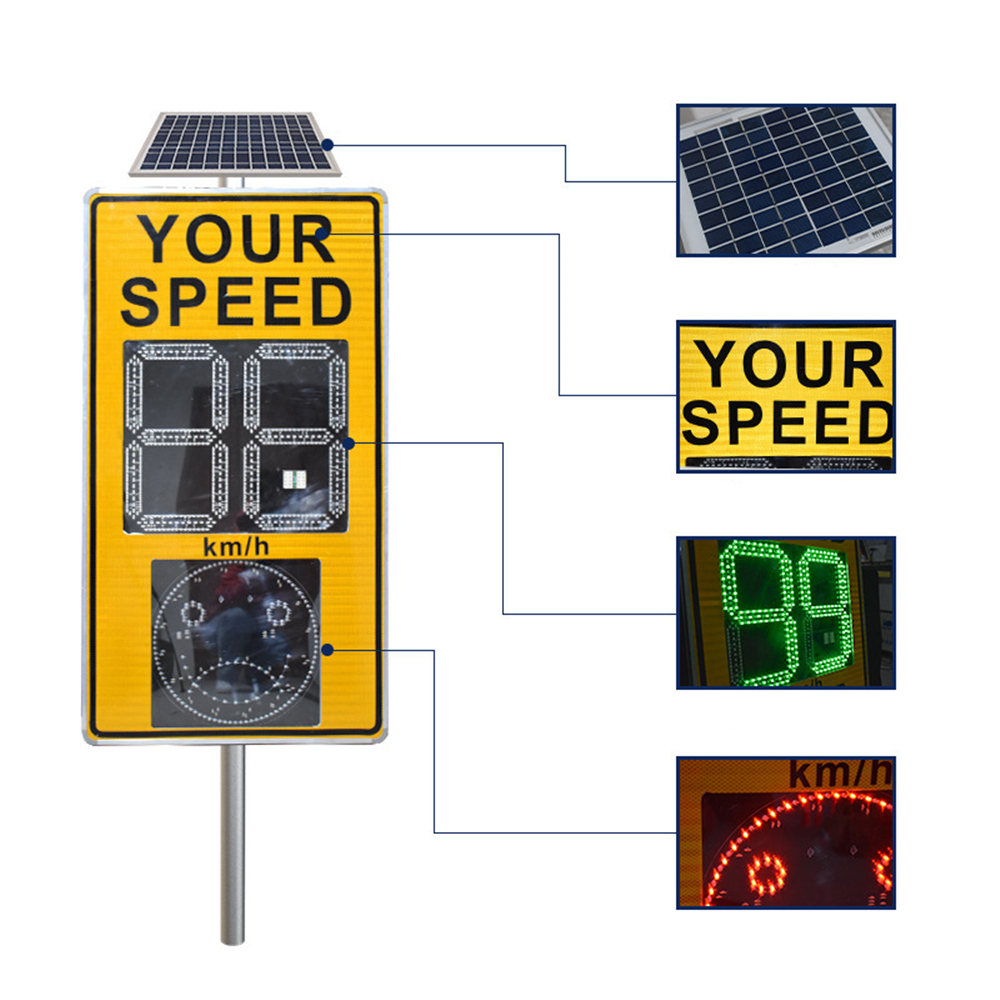How to choose a suitable radar sign
As a key facility to ensure road traffic safety, radar signs can regulate the speed of vehicles, effectively reduce the occurrence of traffic accidents, and provide strong enforcement basis for traffic management departments. However, in the face of various radar signs with different functions on the market, it has become an urgent issue for traffic management departments, road builders, and related practitioners to choose the most suitable products. This article will explore in detail the key points of selecting suitable radar sign from multiple perspectives.

1、 Select based on the usage scenario
Highway scene
Highways have the characteristics of fast speed and high traffic volume, which puts strict requirements on the performance of speed indicators. In terms of installation form, large cantilever or gantry speed indicators are more ideal. Its installation height is usually around 5 to 7 meters, which ensures that drivers can clearly recognize the signage information from a distance while driving at high speeds.
In terms of speed measurement range, considering that the maximum speed limit on highways is generally 120 kilometers per hour, the speed measurement range of speed indicators must cover this value and have extremely high accuracy. Research shows that on highways, if the speed measurement error exceeds 5%, it may lead to misjudgment or omission of speeding behavior, thereby weakening the regulatory effectiveness of radar signs. Therefore, the speed measurement error should be strictly controlled within a small range, and it is generally recommended not to exceed ± 2 kilometers per hour.
Urban road scene
The urban road conditions are complex, with pedestrians, non motorized vehicles, and motorized vehicles mixed in. The speed is slower compared to highways, but changes frequently. Column style speed indicators are more suitable for urban roads, with installation heights generally ranging from 3 to 5 meters. This not only does not affect the aesthetics of urban roads, but also ensures that drivers can read information clearly from a normal driving perspective.
The speed limits on different sections of urban roads vary significantly, ranging from 30-40 kilometers per hour near schools and commercial areas to 60-80 kilometers per hour on some main roads. So, the speed range of the speed indicator should be able to flexibly adapt to these different speed limit requirements. At the same time, to avoid distracting the driver’s attention in complex urban environments, the display content of the signs should be concise and clear, highlighting key information such as the current speed limit and real-time vehicle speed.
Special Area Scenarios
School area: The surrounding area of the school is an area with frequent children’s activities, and ensuring traffic safety is extremely important. A small solar radar sign is a good choice, with an installation height generally ranging from 2.5 meters to 4 meters, which is convenient and flexible to install. The solar power supply method is energy-saving and environmentally friendly, which is suitable for places with high environmental requirements such as schools. The speed range is usually set between 20 kilometers per hour and 40 kilometers per hour to ensure the safety of students’ travel. In addition, radar signs with voice prompts can promptly remind drivers to slow down and enhance the warning effect when vehicles enter the area.
Hospital area: It is also necessary to maintain a low speed around the hospital to ensure the safe passage of medical personnel and ambulances. Similar to school areas, small and flexible radar signs are more suitable. In addition to the conventional speed measurement and display functions, it is also possible to consider adding hospital related prompt information, such as “hospital road section, slow down, yield to ambulance”, etc., to further strengthen the safety awareness of drivers.

2、 Display mode selection
LED digital display: LED digital display is a common way of displaying speed indicators. Its advantage is high brightness, which ensures good visibility even in strong light or nighttime environments. Meanwhile, the lifespan of LED digital tubes is relatively long, usually up to 5-10 years, reducing the cost and maintenance workload of replacing display components. This display method is concise and clear, and can quickly convey key speed information to the driver, such as real-time vehicle speed and speed limit values. Therefore, in outdoor environments, especially in scenes such as highways and urban main roads that require high visibility, LED digital display radar signs are widely used.
LCD display: The speed indicator displayed on the LCD screen can display richer information. In addition to the basic speed and speed limit values, it can also display speeding percentage, vehicle driving direction, illegal prompts, and other content. Its display effect is clear and delicate, providing a better visual experience. However, the visibility of LCD screens is relatively poor under strong light, and this problem needs to be solved by increasing brightness or using special anti glare technology. In addition, the cost of LCD screens is relatively high, and the requirements for installation and maintenance are also more stringent. Therefore, speed indicators displayed on LCD screens are more suitable for use in areas with higher requirements for information display and relatively stable lighting conditions, such as important intersections and toll stations on urban roads.
3、 Warning function selection
Voice warning: The voice warning function can provide clear voice prompts to the driver to reduce the speed when the vehicle is speeding. This intuitive warning method can effectively remind drivers when their attention is distracted or they fail to pay attention to the speed indicator display information in a timely manner. Especially in areas with high safety requirements such as schools and hospitals, voice warning functions can enhance drivers’ safety awareness and reduce the occurrence of speeding behavior. The content of the voice warning can be customized according to different scenarios, such as “You have exceeded the speed limit, please slow down”, “School section, please pay attention to safety”, etc.
Flash warning: Flash warning has a significant effect at night or in poor visibility conditions. When the vehicle is speeding, the flashing lights on the speed indicator will quickly flash, attracting the driver’s visual attention. This warning method can instantly catch the driver’s attention and make them quickly aware of their speeding behavior. The brightness and flashing frequency of the flash can be adjusted according to actual needs to achieve the best warning effect. At the same time, the combination of flash warning and voice warning can form a multi-dimensional warning system, further improving the warning effect of speed indicators.
4、 Price and Budget
The prices of speed indicators of different types and functions vary greatly. When making a choice, it is necessary to consider both actual needs and budget comprehensively. For some budget limited projects, such as the construction of speed measurement facilities on rural roads, cost-effective products can be prioritized to control costs while meeting basic speed measurement and warning functions. For example, choosing a basic radar speed measurement combined with LED digital display speed indicators is relatively affordable and can also meet the basic needs of speed supervision on rural roads.
For important road sections that require high speed accuracy and functionality, such as key nodes on highways, even if the budget is relatively sufficient, a reasonable cost-benefit analysis is needed to select products that match performance and price. We cannot blindly pursue high functionality and high configuration at the expense of cost, nor can we sacrifice the key performance of the product in order to reduce costs.
Choosing the appropriate speed indicator is a complex and systematic task that requires comprehensive consideration of usage scenarios, speed measurement technology, functional characteristics, as well as brand quality, price budget, and maintenance and after-sales service. Only by comprehensively weighing various factors based on actual needs can reliable, functional, and cost-effective radar signs be selected, effectively playing their role in traffic management and ensuring road traffic safety and smoothness.
